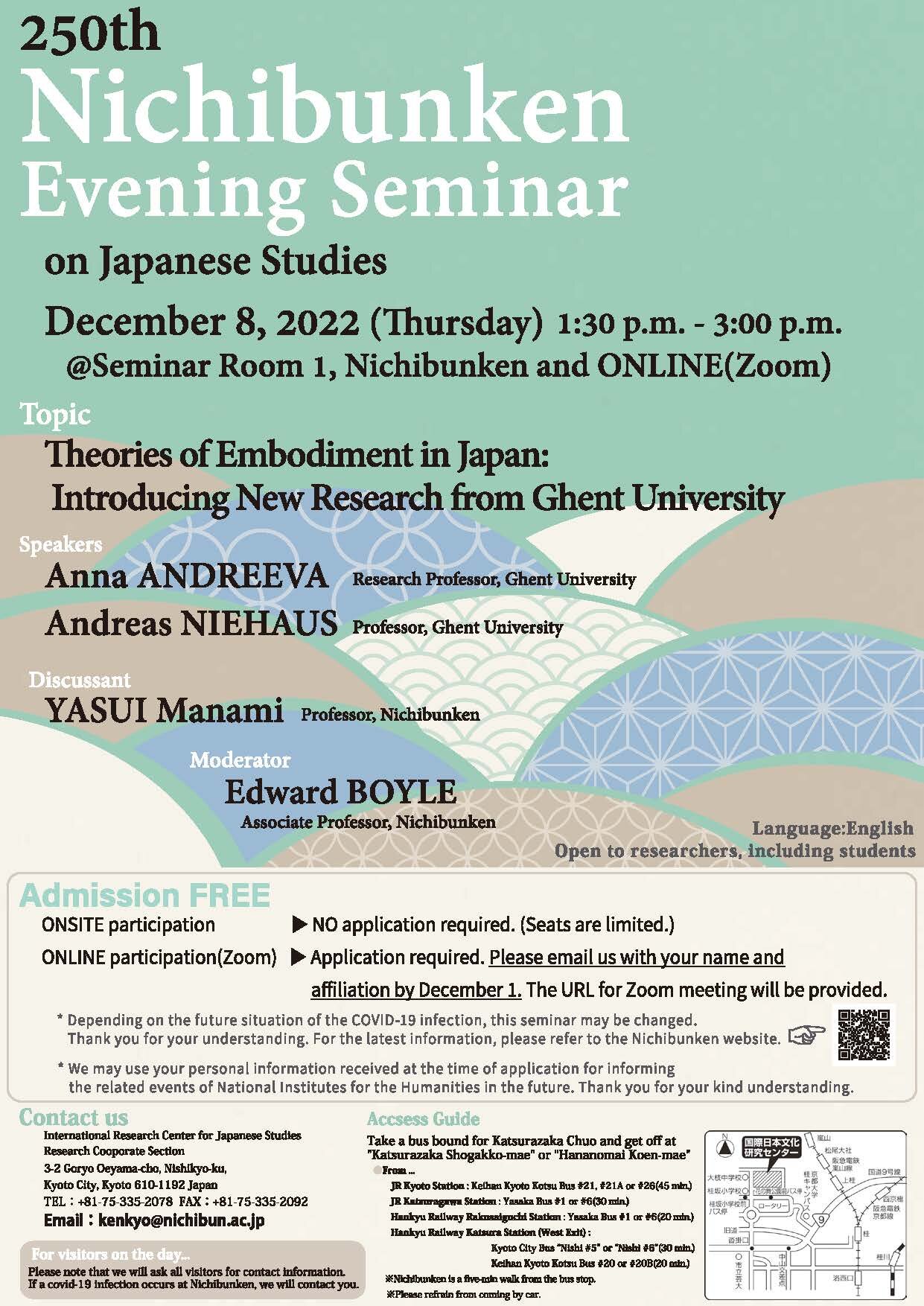The 250th Nichibunken Evening Seminar
 Theme
Theme
 Overview
Overview
 ▶ view PDF
▶ view PDF
|
In principle, ordained Buddhist monks are not supposed to touch women. The Vinaya regulations for male monks guard strongly against physical contact with lay women and nuns. And yet, in medieval Japan, Buddhists had a keen (if detached) interest in the inner workings of women’s bodies. Recent research reveals a little-studied tradition of compiling handbooks and encyclopaedias on childbirth and women’s health by Japanese scholar-monks, who specialized in esoteric teachings and rituals, such as those of Tendai and Shingon. These written compendia presented the Buddhist knowledge of women’s reproductive bodies and mechanisms of transmigration of souls gleaned from pre-existing Indian and Chinese Buddhist philosophical treatises, sutras, and ritual manuals – mostly of esoteric persuasion. In addition to the embryological and ritual knowledge, such compendia included Indian and Chinese medical formulas, as well as talismans and descriptions of tasks to be performed by other experts, present during labour. Focusing on medieval manuscripts rediscovered at Japanese temples and archives, this article traces the adoption of Indian and Chinese pharmacological knowledge on aiding conception, which was historically linked with esoteric deities Hārītī (Kariteimo 訶梨帝母) and Mañjuśrī (Monju 文殊), and Avalokiteśvara (Kannon 観音) and came to be transmitted in Japan since at least the late 9th century. These medical formulas and worship of esoteric deities were adopted by early and medieval Japanese temple milieu for the benefit of noble women from aristocratic families, who could potentially become imperial or shogunal wives and consorts. This project investigates the impact of medical and religious concepts and theories on the formation of knowledge about human organs and gendered health in premodern Japan. Its aim is to write cultural histories of the five viscera, pregnancy, and childbirth as seen through the Buddhist, medical, and prognostication manuscripts from Japanese archives. This project thus analyses the primary source materials that were previously not considered significant by the historians of Japan or East Asia who so far tended to privilege classical Chinese medical sources. It rectifies this problem by considering the premodern Japanese text corpora against the background of transcultural flows of Buddhist and medical knowledge on men’s and women’s health from premodern India, China, and Korea that brought with them Buddhist scriptures and medical texts as well as ritual technologies focusing on illness, risk control, divination, longevity, and talisman writing. On February 27, 1921, the national Yomiuri Newspaper in its morning edition titled “Arrival of heroic price fighters” to announce that the catch-as-catch-can wrestlers Ad Santel and Henry Weber had come to Japan to engage in several public bouts at Yasukuni Shrine against fighters from the Kōdōkan judo school. The event attracted much media attention in Japan as well as the US. The major national newspapers covered the events ahead with background stories and advertisements like “World’s Best Price Fighters with Superhuman Power Santel and Weber against Kōdōkan Masters” (Asahi Shimbun, 12.5.1921) and about 25,000 spectators went to see the fights during the two days. This “Santel incident” (Santeru jiken) had a significant impact on the future development of judo and marked a turning point (Marushima 2006, 234) in the institutional history of the Kōdōkan. In order to understand the significance of the “Santel incident” for Kōdōkan judo in the context of the history of sports in Japan during the early 1920’s, this research project will analyze the 1921 bouts within the context of Kōdōkan judo’s institutional history. Based on an extensive analysis of contemporary primary sources, it will be argued that the challenge by American wrestlers on Japanese grounds brought to the surface an underlying tension between the Kōdōkan Headquarter and affiliated town dōjō, as well as the institutional establishment and a younger generation, led by 5th dan Okabe Heita. This generational tension to a certain degree reflected a loss of institutional power and control of the founder and the founding generation, but moreover mirrored divergent visions concerning the definition, as well as the technical development of Kōdōkan judo as sport. The proposed project aims to better understand the influence of Neo-Confucian ethics on the perception of the human body, particularly as seen in early modern Japanese popular vernacular literature on health cultivation (so-called books on Nurturing Life or yōjō). The research will mainly capture the crucial period from the 18th- into the early 19th century when the popularization of ‘Nurturing Life’ literature widely disseminated ideas of healthy living to a lay-audience, in the process inextricably linking the body’s materiality and its performance to moral imperatives. In this way, ideas about the body and bodily practices at the time reflect the gradual naturalization of Neo-Confucian ethics, which became inscribed onto the body as rules or regimen, seeking to create bodies that were both physically and morally ‘healthy’. |
|
|---|---|---|
-
Speakers
Anna ANDREEVA
Andreas NIEHAUS
Research Professor, Ghent University
Professor, Ghent University
- Discussant YASUI ManamiProfessor, International Research Center for Japanese Studies
- Moderator Edward BOYLEAssociate Professor, International Research Center for Japanese Studies
 Information
Information
| Date: | 2022.12.08 (Thu) |
|---|
- PlaceSeminar Room 1, International Research Center for Japanese Studies and ONLINE (Zoom)
- Start time 13:30 (JST) * Start time is different from usual. Please be aware of this.
- End time 15:00
- Target audience Open to researchers, including students
- LanguageEnglish
- Participation
If you would like to take part in this seminar ONLINE, please email us with your name and affiliation by December 1. URL for the Zoom meeting will be provided by the day before this seminar.
- Emailkenkyo*nichibun.ac.jp (Please replace * with @.)
- NoteWe may use your personal information received at the time of application for informing the related events of National Institutes for the Humanities in the future. Thank you for your kind understanding.
- Report:https://www.nichibun.ac.jp/ja/topics/news/2022/12/22/s001/
- Emailkenkyo*nichibun.ac.jp (Please replace * with @.)

